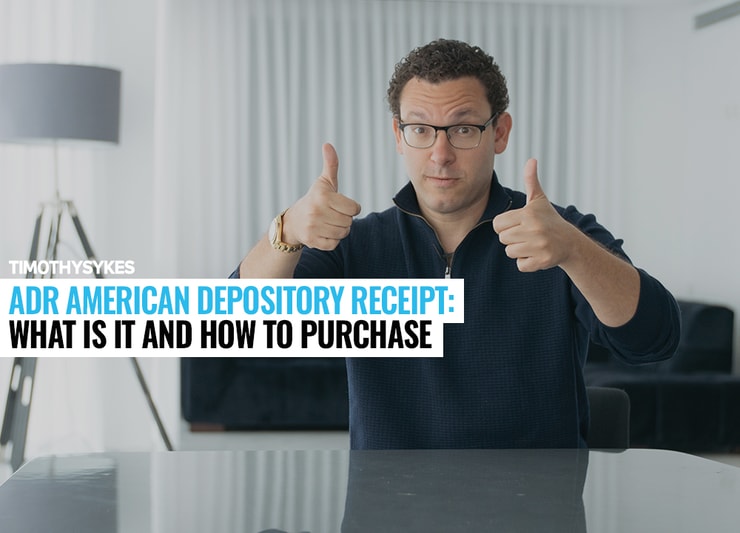If you’re looking for a relatively easy way to diversify your portfolio with international investments, you may want to consider trading American depositary receipts (ADRs)
ADRs offer investors a hassle-free way to purchase shares of international companies without having to deal with foreign markets or contend with hefty overseas banking fees.
Here’s a comprehensive overview of what ADRs are so that you can decide whether they’re an investment method of interest to you.
Table of Contents
What Does ADR Mean?
American depositary (sometimes also spelled depository) receipts are securities that allows foreign companies to trade on the U.S. financial exchanges.
A Practical Example of Trading ADRs
Think of it this way: Say you wanted to buy shares of the stock of a Swiss chocolate company. You’d need to set up a Swiss brokerage account, deal with converting currencies, overseas bank fees, time-zone differences, and many more headaches.
But ADRs provide an easier option for investing in the company.
ADRs allow shares of the non-U.S. company to be traded on the U.S. exchanges via depositary banks that manage the currency and local tax issues. These shares or securities are called American depositary shares (ADSs).
So, it’s a way to easily invest in a business — like the hypothetical Swiss chocolate company — without having to jump through so many hoops.
How Do American Depositary Receipts Work?

2025 Millionaire Media, LLCIf you’re not buying shares of a foreign stock directly, how do ADRs work?
It starts with a foreign company wanting to be listed on the U.S. exchanges. Provided that they meet certain requirements, they can issue a depositary receipt, which can be traded like stocks.
Let’s go back to the example of the Swiss chocolate company. Say this company wants to be listed on the U.S. exchanges. The way it moves forward is that a U.S. broker purchases the shares from the company, then they’re handled through a local custodian bank while they make their way to the depositary bank.
Now, to press pause for a moment, if you’re not familiar with the term custodian bank, according to Investopedia, it’s “a financial institution that holds customers’ securities for safekeeping so as to minimize the risk of their theft or loss. A custodian holds securities and other assets in electronic or physical form.” Basically, this is the place that holds shares for a holding period.
Then, it’s off to the depositary bank. This is the U.S. institution responsible for issuing the ADRs in the United States. Now, both banks verify that the shares have traversed as needed, and the depositary bank can give the ADRs to the broker who initiated the purchase.
Once the ADRs are issued, it can be traded on the stock exchanges. All of the transactions will take place as if they were regular stock exchange transactions, and will be conducted in U.S. dollars, with the same rights and privileges of regular stock shares.
Mechanism of American Depositary Receipts
You may be wondering how the shares translate to the U.S. market. We’ll get more into the ratio in a bit, but the short answer is that each ADR may represent either a single, or more, local shares of the foreign stock in question.
The price will be issued in dollars, converted from the local currency price. There are several types of ADRs: sponsored, unsponsored, Level I, Level II, and Level III. Let’s go through those right now.
Sponsored and Unsponsored
Most ADRs are what is called sponsored based on who is acting as the issuer. However, there are also some ADRs that are considered unsponsored.
Unsponsored ADR shares are traded on the OTC (which stands for ‘over the counter;’ learn this and more key stock market terms here) market. They’re issued based on market demand; there’s no formal agreement between the foreign company and a depositary bank.
Unsponsored ADRs might be issued through multiple depositary banks. This can be confusing because while the ADRs might be through the same company, the respective banks will only service the shares they have issued.
Level I
The lowest level of sponsored ADRs, and incidentally the most common, are issued via a Level I program. This is because it’s the easiest and quickest way for a foreign company to have ADRs issued in the USA.
With a Level I sponsored ADR, there’s a single designated depositary, which is also the agency which facilitates the transfer.
These Level I shares are only available to be traded over the OTC market. There are minimal requirements with the SEC, and there are no requirements for quarterly or annual reports.
This might start sounding like penny stocks. However, unlike a company offering penny stock shares, the overseas company in question does have to be listed on at least one or more foreign exchanges, and must have information in English, including its domestic annual report.
Sometimes, companies will start with a Level I listing and then upgrade to one of the higher levels in time.
Level II
It starts to get a little more complicated for the foreign company as the level of sponsorship gets higher.
If an overseas company wants to have a Level II standing, it has to jump through a few more hoops. They have to file with the SEC and is held to SEC regulations.
The company must also file a Form 20-F, which is like their version of an annual report for a U.S. company.
They’re also required to meet certain standards, such as the US GAAP (Generally Accepted Accounting Principles) or the IFRS (International Financial Reporting Standards).
It’s a lot more work, but when a company has Level II status, they can be listed on one of the bigger exchanges, such as the NYSE or NASDAQ. It must meet the exchange’s requirements too of course, otherwise it could be delisted or downgraded.
The advantage is that they have greater visibility and greater legitimacy.
Level III
As you probably guessed, Level III status is like being part of the captain’s club at the airport — it’s the highest level that a foreign company can attain in the ADRsphere.
But with great power comes great responsibility, so there are a lot more rules that must be met. Actually, the rules here are even more strict than the standards that most U.S. companies must meet.
A Level III program requires this because it’s actually a bigger offering for the company. They are not only letting shares from their home country be deposited so that they can be traded in the USA.
They are issuing additional shares for the foreign market in hopes of raising capital.
To do this, they are required to issue a prospectus for the shares in form of Form F-1. They also have to meet all of the same standards listed above for Level II.
Because they rely on the U.S. shareholders more heavily, they give them more information. In general, you can find information on Level III companies really easily. This means that as an investor, you can easily access their reports, press releases, and more.
The Importance of American Depositary Receipts
Why do ADRs matter? Let’s look at it from the point of view of the company, and that of the investor.
For foreign companies, ADRs allow them the opportunity to offer shares on U.S.exchanges, in U.S. dollars. This means that they get greater international exposure and can attract a wider and more global investment base.
For investors, the ADR allows them to diversify their portfolio by buying into foreign companies.
However, they don’t have to deal with the many issues that will come up when trading overseas, such as dealing with foreign banks, delayed information, information printed in languages they may not understand, and perhaps most importantly, baking fees and currency conversions.
How ADS and ADR Relate to Common Stock

2025 Millionaire Media, LLCADS and ADR are kind of like the Google translate version of common stock: they share a lot of similarities, but there are a few little quirks.
ADRs and ADSs have a few differences that are important in differentiating them from common stock.
For one, there’s a big difference in how taxes are charged on dividends. With a common stock, the dividends are U.S. taxable.
With your ADR, the dividends can be taxed by the home country of the company issuing the original stock. These amounts will usually be withheld by the sponsor. however, it is a difference worth noting.
Some investors will apply for a refund abroad so that they aren’t taxed twice. This is important to consider before investing in ADRs.
Trading ADRs
Curious about how to trade ADRs? Here are some of the basics to help you get started.
More Breaking News
- Cipher Mining Ramps Up Production: Bitcoin Hashrate Soars
- Is Expedia Stock Ready to Take Off?
- Sunrun’s Stock Soars on Solar Tax Credit Optimism
How to Buy ADR Stock
If you want to buy ADR stock, it’s really as easy as hitting up the stock market and placing an order. But how do you know if a listing is an ADR or a common stock?
You can filter on the stock exchanges like NASDAQ by “Non-U.S. Issuers” to get a complete list of ADRs that are currently listed. You’ll also find a comprehensive list of ADRs here.
Determining Price
How is the price of ADRs determined? With the ADR ratio.
ADR Ratio
Sometimes, an ADR might be a 1-to-1 ratio with the foreign shares translating to U.S. shares, but this isn’t always the case.
For example, one ADR could be two or more shares. This is done so that the prices can remain competitive with share in the U.S. market.
This refers to the number of foreign shares equal to one ADR. Often, you’ll see it listed as a ratio, such as 2:1 would mean that two foreign shares equals a single ADR.
Supply and Demand
When the ADR is released on the market, like a stock, the price it commands is based on supply and demand.
While ADRs are affected by the trend of the shares in the home country, there can be exceptions. If the U.S. price varies considerably, opportunities for arbitrage trading may exist.
According to Investopedia, “Arbitrage is the simultaneous purchase and sale of an asset to profit from an imbalance in the price. It is a trade that profits by exploiting the price differences of identical or similar financial instruments on different markets or in different forms. Arbitrage exists as a result of market inefficiencies and would therefore not exist if all markets were perfectly efficient.”
How to Take Advantage of ADR Trading
There are a few different reasons why investors find ADR trading alluring.
First, it can make profiting from foreign investments easier. Since ADRs trade on the U.S. stock exchanges, you don’t have to deal with the hassles that come with crossing borders, and this means fewer fees and fewer logistical issues.
Interestingly, one of the key ways that you can profit from ADR trading is by betting against U.S. currency.
For example: If you invest in a company that’s doing well overseas, you’re investing in that company and that country’s national currency has an effect. So, if the dollar falls in value versus the home country of ADRs, the ADR can go up in share price, which can net you profits.
Master Your Trading Skills with My Trading Challenge
If you want to become a successful trader, you must invest in your education. I established my Trading Challenge to help guide my students through the basics of the market and beyond, so that they can forge successful trading careers.
By learning how the market works and building a skill set slowly but steadily, my students form a strong trading foundation and learn how to think for themselves.
My students are insanely smart and dedicated to the process, and it shows in their results. At this point, several of my students (including this one) have exceeded $1 million in profits!
Risks of Investing in ADRs
Investing in ADRs isn’t without its risks. Here are a few to consider:
Political Risk
Obviously, the economy has a different climate in different countries. So don’t count on an ADR stock performing the same as a U.S. investment.
Be sure to do your due diligence. Research the economy and status of the country in question. Is there anything that could alter the financial outlook of the country on the horizon?
Are there sanctions from the U.S., or is there any other developing financial news? Just as you would look for a catalyst and information about the company for a penny stock trade, you must do the same with ADRs but add into the mix a little research about the country in question.
Exchange Rate Risk
While ADRs do a good job of smoothing out the edges of conversions by allowing you to purchase in U.S. dollars, the currency rate still has an effect on the shares.
The fluctuating value of the dollar and the other currency in question can have an impact on your earnings, as they’ll need to be converted into U.S. dollars before you receive them.
Be sure to investigate the currency of the home country of the security you’re buying. If the currency isn’t stable or has low value, this can have an effect on your ADR investment. Even if the company seems to be doing well, this can result in a loss.
While ADRs help out with the headache of foreign exchange rates and taxes directly when buying, the exchange rate still matters.
Inflation Risk
Along with the exchange rate, remember to be aware of the inflation risk.
Inflation is the rate at which things like services and goods go up in price over time. You know, like your parents talking about how back in their day, a candy bar only cost a penny.
While inflation is natural to a certain degree, if the inflation rate isn’t balanced between the U.S. and the country where the ADRs are from, the investment can lose its value. It’s important to be aware that high inflation can affect your ADR investment.
Frequently Asked Questions

2025 Millionaire Media, LLCWhat Are the Advantages and Disadvantages of ADRs?
Like anything in life, ADRs offer pros and cons for investors. Here’s a breakdown of some of them:
ADVANTAGES:
- ADRs offer investors an easy and hassle-free way to buy shares in foreign companies, with reduced admin costs, conversion struggles, language barriers, etc.
- Taxes are simplified with investing in ADRs versus foreign companies directly.
- Usually, the price of ADRs are cheaper than individual shares of stock because of the ADR ratio.
- For the foreign companies, they gain a greater audience in the U.S., which means they can tap into different and more vast markets.
- Foreign companies can help you gain higher returns. Currency fluctuation, the value of the dollar, and even inflation can potentially be used to your advantage.
DISADVANTAGES:
- Currency conversion fluctuation. The very same inflation and currency fluctuation rates that can help you profit are a double-edged sword and can also result in losses, depending on how the market is going.
- The offerings are limited. Not every foreign company is willing to do the necessary work for sponsorship for to offer ADRs. This means that the offerings are limited for buyers.
- As an investor, you need to hold on to your shares for a long time for good returns.
- Taxing can get tricky. You can be double-taxed on your returns from the IRS and from the issuing country on dividends.
When to Use ADRs
ADRs probably aren’t the first type of investment you’ll tackle when you begin trading. However, if you’re interested in adding an international element to your investing, it may be worthwhile to explore them as your career advances.
ADRs allow you to make targeted investments, so you can invest in particular industries or countries that could be emerging strongly. Given that the stock market is ever-shifting, having some investments overseas might not be such a bad idea.
ADRs aren’t the only option for overseas investing. Read this post on forex trading for another approach to foreign investment, or this post on investing in the Asian markets.
Are ADR Fees Tax Deductible?
There’s no easy answer to this.
In the eyes of the IRS, an ADR is treated similarly to a domestic investment, which means you may be subject to dividend taxes and capital gains. However, this depends on the country in question and what sort of agreement they have with the U.S.
Many ADRs will have dividend payment taxes withheld, which can be upward of 15 to 20 percent.
You’ll also have to pay income tax on your dividends. Yes, this means double taxing. In some cases, you can claim a deduction for the foreign tax you pay, but once again, this depends on the country.
Be sure to do your research and consult with your broker before investing in ADRs so that you’re not unpleasantly surprised at tax time.
What Are the Differences Between ADR and GDR?
A GDR (global depositary receipt) is a certificate issued by a bank for shares of foreign companies, which trade as domestic shares. It’s a way of raising capital, primarily in the U.S. and European markets.
Per Investopedia, “A GDR a financial tool that is used by private markets to raise capital that is denominated in either American dollars or euros. They are called European depositary receipts when private markets are trying to get euros.”
Wait, sounds a lot like an ADR, right? So what’s the difference?
The Process of Issuing ADR and GDR
While GDRs are similar to ADRs, there’s an important difference. GDRs let the issuer raise funds in multiple markets simultaneously. This allows them greater exposure.
According to ADR.com, “The GDR is generally structured as a combination of a Rule 144A ADR, which trades in the U.S. private placement market, and a public offering outside the United States under Regulation S.”
Difference Between Depositary Receipt vs. Common Stock
Just because ADRs can be purchased on the same exchange and are treated similarly to stocks doesn’t mean they’re the same as common stock.
Securities laws keep foreign companies with listings on foreign exchanges to list their shares on the U.S. exchange concurrently. If a foreign company wants its shares to be available in U.S. dollars on the U.S. exchanges, ADRs are the way to do it.
Conclusion
If you’re interested in adding a global dimension to your portfolio but don’t know where to begin, ADRs may be worth considering. ADRs offer the opportunity to invest overseas with minimal confusion and hassle, and can help you benefit from the financial success of other regions of the world.
Have you ever traded ADRs?









Leave a reply